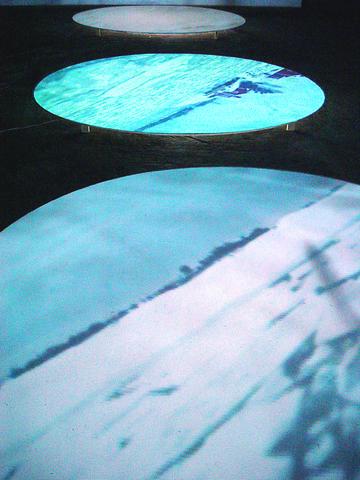Living in a foreign country often helps a young artist realize his or her creative potential to a greater extent than would otherwise have been possible. So it comes as now surprise that more and more young Taiwanese artists are seizing the opportunity (presented by the increasing number of exchange programs available to them) to spend several months away from an environment that sometimes seems too provincial for their active minds.
In the case of Wu Dar-kuen (
Streamer is a subtle reflection on the interplay between space and time. Beautiful and without irony, the installations are a marked departure from his previous vivacious works fantasizing about the technological future of the human race.

PHOTO COURTESY OF THE ARTIST
"The movement of a ray of light shooting across the sky from one place to another, which is what `streamer' means, is what I'm trying to show here," said Wu, relating the works to his journey to the far side of the earth and back.
Inside the pitch-dark gallery, three round screens, placed at ground level, show monochrome DVD projections of a flowing snowflake-dotted stretch of water. While two of them are played at normal speed, the third is always set at fast-forward. As if standing next to these nearly frozen rivers on screens in the dark is not haunting enough, three speakers that beam digitally distorted sounds of a boat navigating the water into viewers' ears to add to the bleak mood of the installation. Even inside the gallery, the soundtrack, with its eerie beeps and pings, creates an ambience that might induce agoraphobia. The video was shot from a boat en route to Helsinki. As shown here, the passage seems an experience as beautiful as it is cold and desolate.
Away from Taipei's lively social circle and bustling night life, Wu spent early winter last year on an islet off Helsinki, where he often went for days on end without speaking to a single person. The most readily available diversion, Wu said, was talking to himself.
Another DVD installation shows images of snow falling on the ground, on a house, on a tree and so on, played in reverse. Like the one shot from a boat, these are bleak but beautiful.
Constructing an atmospheric evocation of the Arctic winter almost obscures Wu's real intention -- musing on the workings of space and time. Intended as imageries of introspection, these DVD installations at times resemble travelogues, of which there are more than enough in Taiwan.
Streamer - A Solo Exhibition by Wu Dar-kuen runs through March 8 at Bamboo Curtain Studio, located at 39, Lane 88 Chungcheng E. Rd., Sec. 2, Tamshui, Taipei County (

On April 26, The Lancet published a letter from two doctors at Taichung-based China Medical University Hospital (CMUH) warning that “Taiwan’s Health Care System is on the Brink of Collapse.” The authors said that “Years of policy inaction and mismanagement of resources have led to the National Health Insurance system operating under unsustainable conditions.” The pushback was immediate. Errors in the paper were quickly identified and publicized, to discredit the authors (the hospital apologized). CNA reported that CMUH said the letter described Taiwan in 2021 as having 62 nurses per 10,000 people, when the correct number was 78 nurses per 10,000

As we live longer, our risk of cognitive impairment is increasing. How can we delay the onset of symptoms? Do we have to give up every indulgence or can small changes make a difference? We asked neurologists for tips on how to keep our brains healthy for life. TAKE CARE OF YOUR HEALTH “All of the sensible things that apply to bodily health apply to brain health,” says Suzanne O’Sullivan, a consultant in neurology at the National Hospital for Neurology and Neurosurgery in London, and the author of The Age of Diagnosis. “When you’re 20, you can get away with absolute

May 5 to May 11 What started out as friction between Taiwanese students at Taichung First High School and a Japanese head cook escalated dramatically over the first two weeks of May 1927. It began on April 30 when the cook’s wife knew that lotus starch used in that night’s dinner had rat feces in it, but failed to inform staff until the meal was already prepared. The students believed that her silence was intentional, and filed a complaint. The school’s Japanese administrators sided with the cook’s family, dismissing the students as troublemakers and clamping down on their freedoms — with

As Donald Trump’s executive order in March led to the shuttering of Voice of America (VOA) — the global broadcaster whose roots date back to the fight against Nazi propaganda — he quickly attracted support from figures not used to aligning themselves with any US administration. Trump had ordered the US Agency for Global Media, the federal agency that funds VOA and other groups promoting independent journalism overseas, to be “eliminated to the maximum extent consistent with applicable law.” The decision suddenly halted programming in 49 languages to more than 425 million people. In Moscow, Margarita Simonyan, the hardline editor-in-chief of the